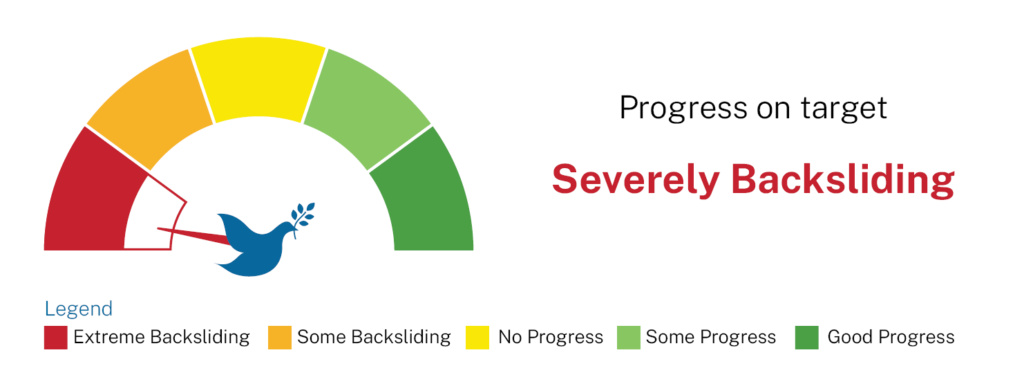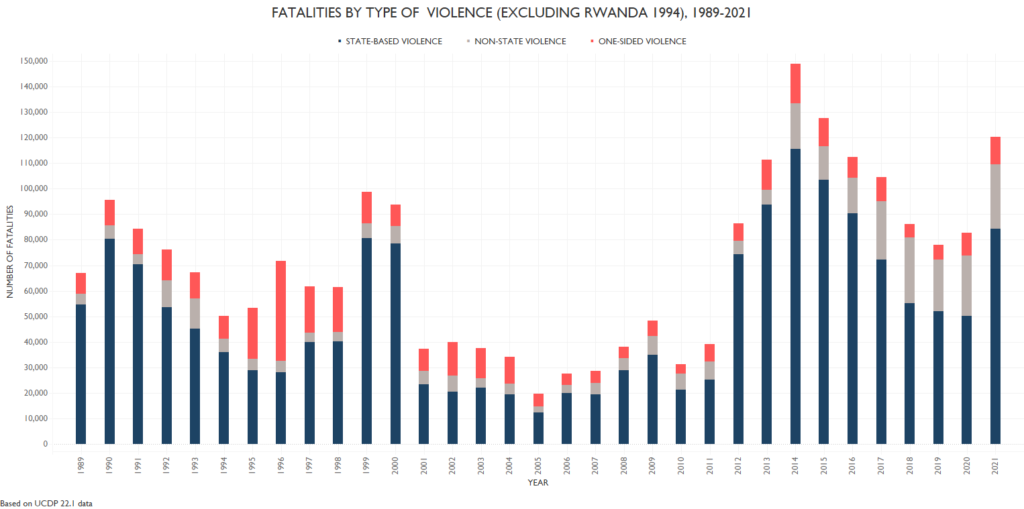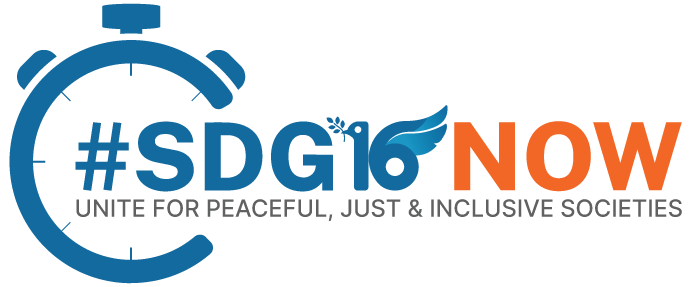Target 16.1: Significantly reduce all forms of violence and related death rates everywhere

There has been a long-term decline in homicides, the feeling of safety has remained steady, and Positive Peace has improved almost continuously since 2009. However, violence and fragility has peaked in recent years while the number of homicides jumped in 2021. These trends have continued to increase due to the complications of the global pandemic, protracted wars (including Ukraine and other civil wars in Ethiopia and Sudan) and the backsliding of democracy and increasing conflict dynamics in the global north.
Authors of chapter



Context and Interlinkages
In 2018, the global landscape witnessed a record high in violent conflicts and fragility, marked by an escalationin conflict trends. In 2023, more than 117 million people will be displaced due to increasing conflict and violence, and an estimated 339 million people will need humanitarian assistance and protection globally— the highest figure in decades. Escalating climate change and food insecurity are also compounding violent conflict and violence, and technology is greatly accelerating conflict dynamics.1
The 2030 Agenda document clearly linked development and peace, stating “there can be no sustainable development without peace and no peace without sustainable development.” The goal of SDG 16.1 is to promote peace, reduce violence, measure whether violence and violent conflict is increasing or decreasing and determined if sustainable peace is being built. Lethal violence affects all societies to varying degrees, whether in conflict or post-conflict contexts, or in the form of criminal or political violence. Violence stunts human, social and economic development indicators and erodes the social capital of communities.2 Moreover, conflict is a leading cause of food in security and displacement. The war in Ukraine has shown how conflict can disrupt access to food and fertilizers worldwide. Addressing violence is, therefore, crucial for all SDGs. The target is also linked with SDG 16.2 on violence against young people and SDG16+ indicators on fostering a culture of peace (4.7), safe education (4.a), violence against women and girls (5.2) and child labour and child soldiers (8.7).
Freedom from violence is also interlinked with major international agreements including the right to life, as enshrined in the Universal Declaration of Human Rights and the International Covenant on Civil and Political Rights. There is also a strong connection between freedom from violence and international humanitarian law.
Progress on indicators
Official Indicators:
• 16.1.1: Number of victims of intentional homicide per 100,000 population, by sex and age (Tier I)
• 16.1.2: Conflict-related deaths per 100,000 population, by sex, age and cause (Tier II)
• 16.1.3: Proportion of population subjected to (a) physical violence, (b) psychological violence and (c) sexual violence in the previous 12 months (Tier II)
• 16.1.4: Proportion of population that feel safe walking alone around the area they live (Tier II)
Additional indicators:
• Global Peace Index
• Positive Peace Index
There has been a long-term decline in incidents of homicide as measured by 16.1.1. However, the United Nations Office on Drugs and Crime (UNODC) estimates that 457,000 people were victims of homicide in 2021, a notable increase after the number remained relatively steady from 2015 until 2020.3 Prior to the 2021 increase, there was a projected decline of 19 per cent by 2030. Nevertheless, even this projection fell short of the rate required to meet the goal of a 50 per cent reduction by 2030. Civil society data shows a similar trend. According to the Small Arms Survey’s Global Violent Deaths database, homicide rates have been declining for the past two decades and were down 16 per cent between 2016 and 2020.4 They estimate 78 per cent of all homicides occurred in just 20 countries in 2020.
However, the lack of a universal definition and data-collection methodology for ‘intentional homicide’ also hinders the ability to measure cases of homicide accurately, resulting in inconsistent reporting and questionable accuracy of the collective data. These challenges ultimately lead to an incomplete assessment of what is driving homicide and how to reduce and prevent intentional homicide effectively. Additionally, homicides might not be relevant to measuring peace and security. If homicides decrease, it may be due to negative peace, rendering it only a matter of time before homicides rise again.
The trends for the number of fatalities in armed conflict (16.2.2) are very negative. 2014 was the most violent year since the end of the Cold War. Additional types of violence – conflict between non-state actors and violence targeting civilians – increased substantially in 2014.5 In 2018 the world hit a global high in violent conflict and fragility, and the invasion of Ukraine in 2022 has exacerbated levels of conflict and instability. The Office of the United Nations High Commissioner for Human Rights (OHCHR) reported a sharp decline in deaths from 70,000 in 2015 to 11,000 in 2021, but it only applies to 12 conflicts out of an estimated 41 major conflicts. The number increased over 50 per cent in 2022 to nearly 17,000. Civil society sources have found higher rates but similar trends. The Uppsala Conflict Data Program estimates that deaths due to organised violence (state-based armed conflict, non-state conflict, and one-sided violence) hit a high in 2014 then declined briefly before spiking again, with a 46 per cent increase in 2021 alone.6 Similarly, in 2020, the Small Arms Survey reported that 103,00 persons died in conflicts, down from 190,000 in 2016. The war in Ukraine has worsened the situation, but data will not be available for another year to show exactly how much.
However, once again, a shortage of data hinders efforts to address ‘intentional homicide’ and ‘conflict affected deaths’ in fragile and conflict-affected settings. There are no universal data collection standards for conflict-related violence, and when data is available, it can be unreliable, even in non-conflict-affected and fragile settings. These inconsistencies lead to data gaps, ineffective analysis, and questionable or misleading findings. The reporting on conflict-related deaths varies significantly from country to country, and many countries do not adhere to the international standard for combatant death measurement. In conflict-affected countries, data collection has tremendous shortcomings, making reliable data collection from actors on the ground unfeasible.7

Source: Uppsala Conflict Data Program. https://ucdp.uu.se/exploratory
There is only limited data available for analysis relating to the reporting of physical violence, psycho-logical violence and sexual violence (Indicator 16.1.3). According to UNODC, physical-violence data is only available for 41 countries, while sexual-violence data is only available in 32 countries. At the same time, in 2022, the official data for the related SDG16+ Indicator 5.2 describes violence against women and girls as “prevalent across countries and affects women of all ages.” Additionally, violence against women hit record highs during the COVID-19 pandemic lockdowns.8 Further, the victimisation surveys usually do not include children. A more significant problem is the definition of each of these offences, which vary significantly between countries.
According to UNODC, the percentage of persons who feel safe walking around alone where they live (Indicator 16.1.4) remained steady between 2016 and 2021, slightly declining from 70 per cent to 69 per cent.9 There is a significant gender gap present however, with women reporting a rate of feeling safe 10 per cent less than men did. The Gallup Global Law and Order 2022 report recorded the feeling of safety at 71 per cent for 2021, up from 60 per cent in 2014.10 The Safety Perceptions Index, which is based on the World Risk Poll, found that worry about violent crime was high across most countries but declined slightly between 2019 and 2021.11 At the same time, first-hand experience of crime was considerably lower than perceived worry. It found that those who accessed traditional and (more unreliable) alternative media sources were 16 per cent more likely to be fearful of violent crime.
Additional Indicators
SDG 16.1 indicators measure the absence of violence which is critical to ascertain whether a society is becoming more violent or less violent. However, the indicators cannot measure if a country is advancing Positive Peace, a form of peace which goes beyond preventing and reducing violent conflict and measures if a society is building sustainable peace.
The Global Peace Index 2022, which measures peacefulness across three domains: ‘Safety and Security’, ‘Ongoing Conflict’, and ‘Militarisation’, found that the average level of global peacefulness went down by 0.3 per cent in 2021, with the largest declines being related to deaths from internal conflict and ‘political terror’.12 The index has recorded a decline every year since 2014. It found the declines are the largest in established democracies and relate to violent demonstrations and external and internal conflicts.

The SDGs should include Positive Peace indicators such as social cohesion. As measured on leading indices, social cohesion is a critical antidote to building resiliency against grievances which drive violence and violent conflict and to building sustainable peace. Positive Peace is associated with social characteristics that are considered desirable, such as levels of inclusiveness and trust, and not merely the absence of violence. An alternative indicator should include Increase in Social Cohesion which can be measured by: 1. Social Capital, which refers to institutional and interpersonal trust measured against individualism; 2. Social Relations, which refers to horizontal networks that exist between individuals and groups; 3. Confidence in National Institutions, which refers to confidence in government institutions, and is crucial for ensuring successful policy implementation.13
This alternative indicator is interlinked and cross-cutting throughout the other SDGs, including SDG 16.3.1 (Victims Report Crime) and 16.3.3 (Dispute Resolution), SDG5 (Gender Equality), and SDG10 (Reduced Inequality). For example, when citizens have confidence in government institutions, including dispute resolution and public safety, they can access trusted public services. Additionally, when a society is equal, people will trust each other and can better work together to build healthy, peaceful and resilient communities.
The Positive Peace Index found that the “attitudes, institutions and structures that create and sustain peaceful societies” improved by 2.4 per cent between 2009 and 2020, with nearly half of that increase since 2015. One-hundred and twenty-six of the countries assessed recorded improvements in that period. One of the greatest areas of improvement related to the “free flow of information” pillar highlighting the linkages of peace to SDG 16.10 on access to information and 17.6 on access to internet. Its greatest decline was in corruption.
Recommendations
To better measure the progress of reducing violence and conflict-related deaths, there must be capacity building and strengthened systems, so there is access to reliable data.
- Ensure conflict prevention and peacebuilding are significantly integrated in other development sectors, such as health, education and humanitarian assistance, with indicators that go beyond conflict sensitivity and also measure how these programmes prevent conflict and build peace.
- The bi- and multilateral donors must provide much-needed resources for conflict-prevention programmes (only 4 per cent of Official Development Assistance [ODA] goes to conflict prevention).
- Capacity strengthening at the local level is essential to record and report “intentional homicides” where viable criminal justice systems and statistics do not exist.
- The international community must adopt a universal standard for collecting, measuring, and reporting data. Adherence to an internationally recognised standard will ensure that data measurement and reporting are consistent across all countries.
- There must be custom indicators to measure peace and security in different country contexts because one-size-fits-all indicators will not truly capture what drives conflict and insecurity and what builds sustainable peace worldwide.
- Countries must commit to reporting conflict-related deaths, and doing so can serve as a model for other countries, demonstrating that the SDGs apply to all, not only countries that are fragile and conflict-affected.
- Developing Positive Peace indicators is critical because we can’t measure a peaceful, just and inclusive society by only measuring negative peace indicators.
Case Study: Consolation East Africa
In 2023, about 240 Kenyans died as a result of religious fanaticism. Their pastor, Paul Mackenzie, convinced them that dying through starvation was a guarantee to reaching heaven. The pastor had procured land in Shakahola Forest which has since been discovered as the site of mass graves. Currently, the search for the deceased continues, but the latest figures indicate that 240 bodies have already been found. The majority of the victims of this religious fanaticism are from poor backgrounds, with a significant number being vulnerable women and children.
Case Study: Shadow reporting in Uganda
SDG 16.1 is being used by countries to measure the reduction in conflict-related deaths and violence. The findings shared in a ‘shadow report’ from 2019 in Uganda found that the government has significantly contained insurgencies and the number of arms within communities, including the Karamoja region, which led to decreased violence and an increased feeling of safety in the country. The Uganda Bureau of Statistics survey in 2018 indicated that 97 per cent of people felt safe walking in their communities; respectively, 94 per cent and 61 per cent felt safe walking alone during the daytime and at night. However, cases of violence at a micro/community level are still a concern and are primarily not recorded and, therefore, go unnoticed. Additionally, on the Fragile States Index, Uganda’s score stayed almost unaltered and remains high on the alert list of countries.

